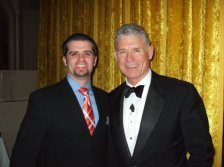Earlier this year, a friend and a parishioner at my former church in Maryland asked me if I would like to give the invocation prayer again at the National Football League’s Players Gala and James Brown Awards. Last year, I gave the invocation prayer at the event and got to meet James Brown (of CBS Sports), Bill Cower (former coach of the Pittsburg Steelers and Super Bowl winning coach), and other NFL players who were nominated for the “JB Award” for outstanding community involvement. The gala also serves as a fundraiser for the Special Olympics. This year, I happily accepted the invitation again and got to meet Ben Roethlisberger (Pittsburg Steelers Quarterback and Super Bowl Champion), Clinton Portis (Washington Redskin running back and Pro-Bowl starter), and Larry Fitzgerald (Arizona Cardinal wide receiver and Pro-Bowl MVP).
As I was traveling to the event, I could not help but wonder what place does a prayer have at a professional sports fundraiser and award show? Sure, as a pastor I believe that we should desire to acknowledge God at these functions, but what do professional athletes think about prayer and invoking the name of God publicly? Do these men of mega strength actively seek God out? Sometimes after professional sports games on television players will mention God in passing as if God was a mere minor character in the player’s life. Or during an interview, when professional athletes mention God more specifically and in great length the interviewer will cut off the athlete move on to more “important” facets of the game such as what edge the athlete had or what the athlete did before the game. Still, some acknowledge “The Almighty”, “God”, or just “being blessed” but rarely mention “Jesus.” In my mind, NFL players were not known for putting Christ as the center of their lives, either privately or publicly.
As I walked around the gala at the Washington D.C. Hilton and started to meet and take pictures with the players, I introduced myself and
mentioned my role in the program. Most players did not say much, but they did allow me to take a picture with them. As the time ticked down to my brief moment of prayer, I was ushered backstage and waited for my cue. As I was waiting, I saw James Brown (J.B.) of CBS Sports, who is the driving force behind recognizing NFL Players and their community involvement at the event. I decided to introduce myself and what I was doing there. J.B., a former football player, affectionately embraced me and started to share with me in great length about his involvement with local pastors, local churches, prayer, accountability partners, and working with other religious organizations. He also opened up about his faith in Christ.
J.B. also said something that got my attention. In a very humble way, he said, “You know, what we do out there is something that is done only by the Holy Spirit. You and I, do this for His sake, not ours.” Wow! Here is a celebrity acknowledging the Holy Spirit. He continued to speak about his faith in Christ and he said he enjoyed our time together as fellow brothers in Christ. He also inquired about my journey with God, my ministry, my connection with the event, and my collegiate career in lacrosse.



 For the last 20 or 25 years, it has become popular a church to build their worship and ministry space to look like a warehouse or storehouse (or use an actual warehouse). After being a part of three capital improvement projects at three different churches, I have found there is a whole theology to church buildings.
For the last 20 or 25 years, it has become popular a church to build their worship and ministry space to look like a warehouse or storehouse (or use an actual warehouse). After being a part of three capital improvement projects at three different churches, I have found there is a whole theology to church buildings. vention.
vention.
